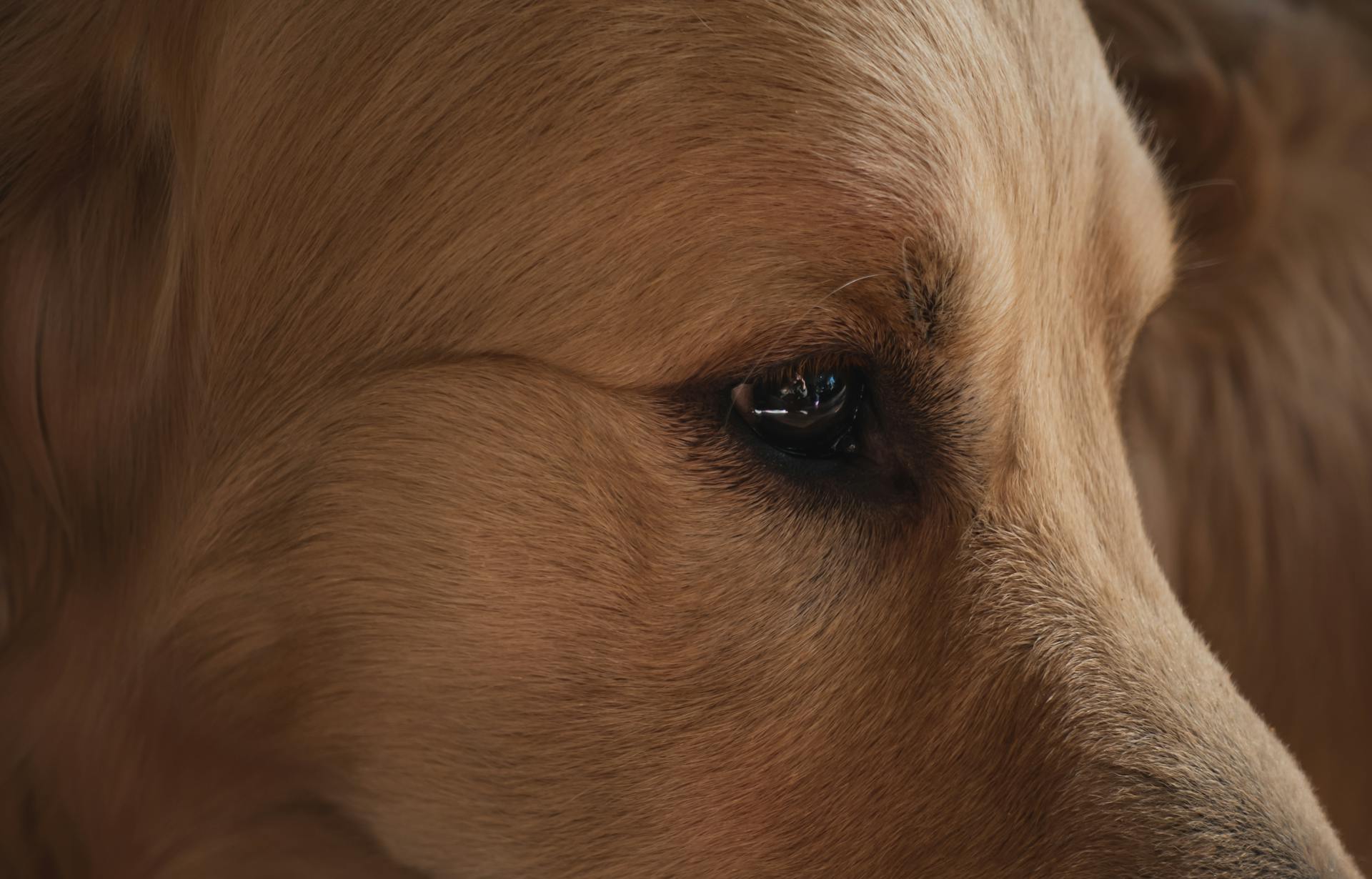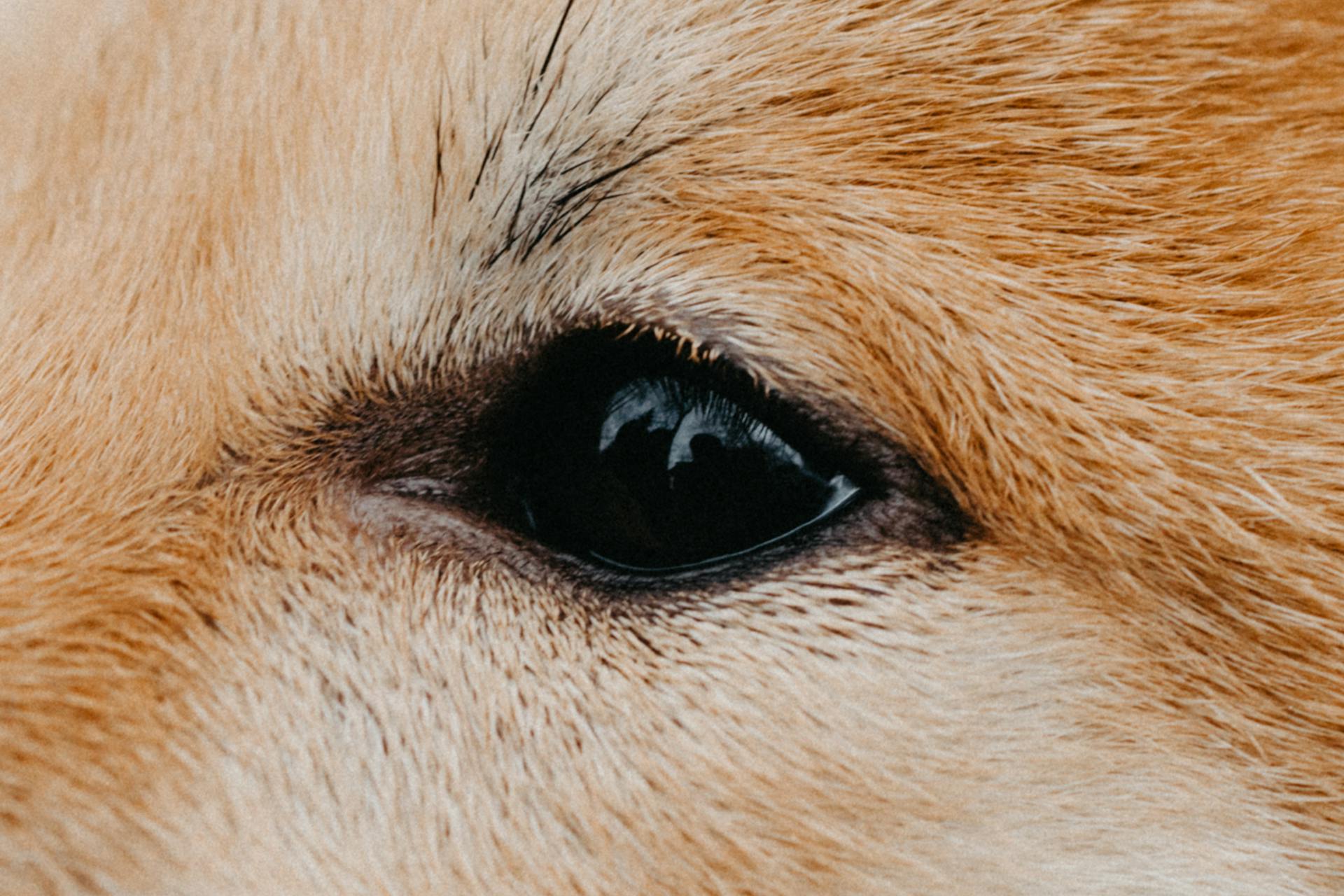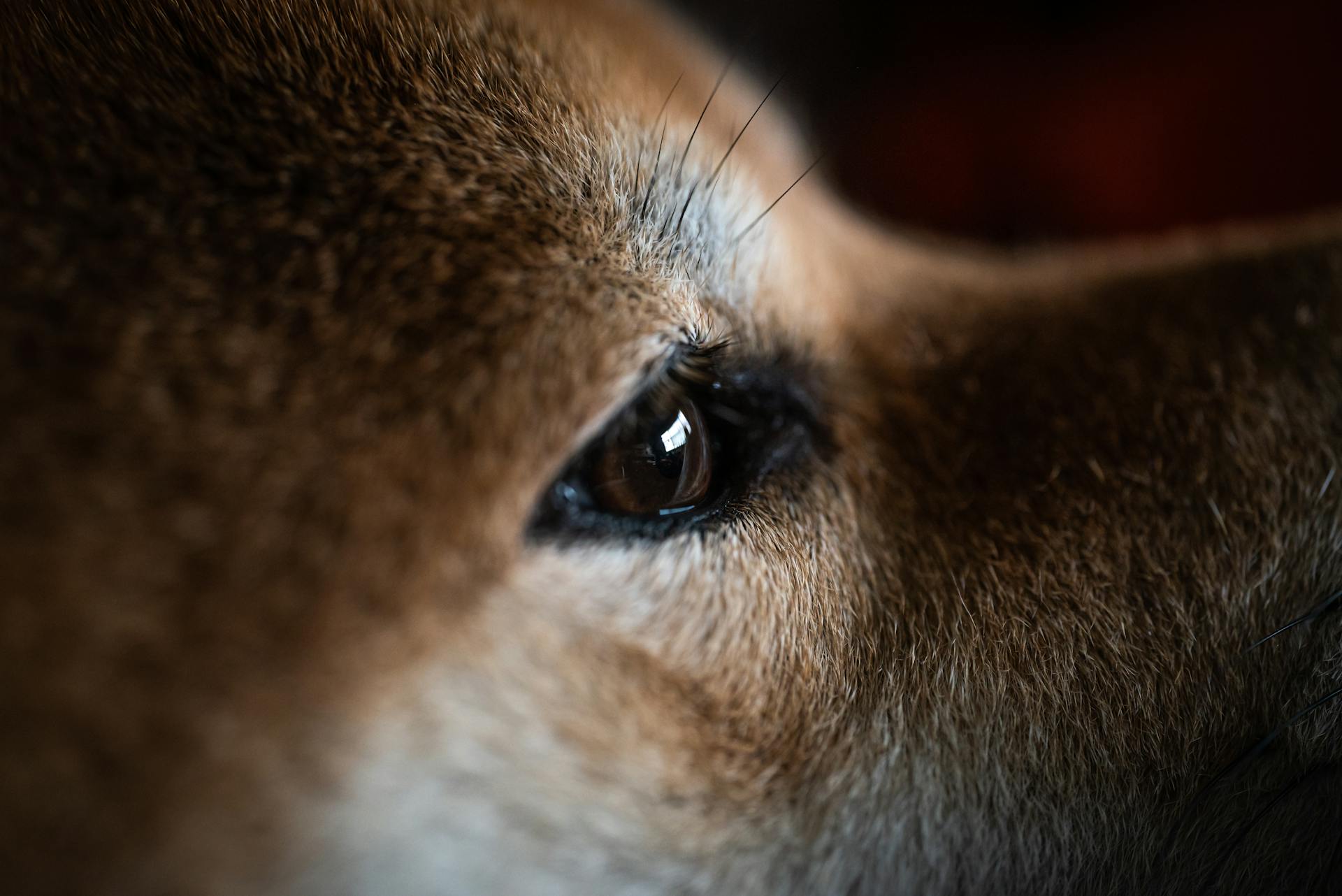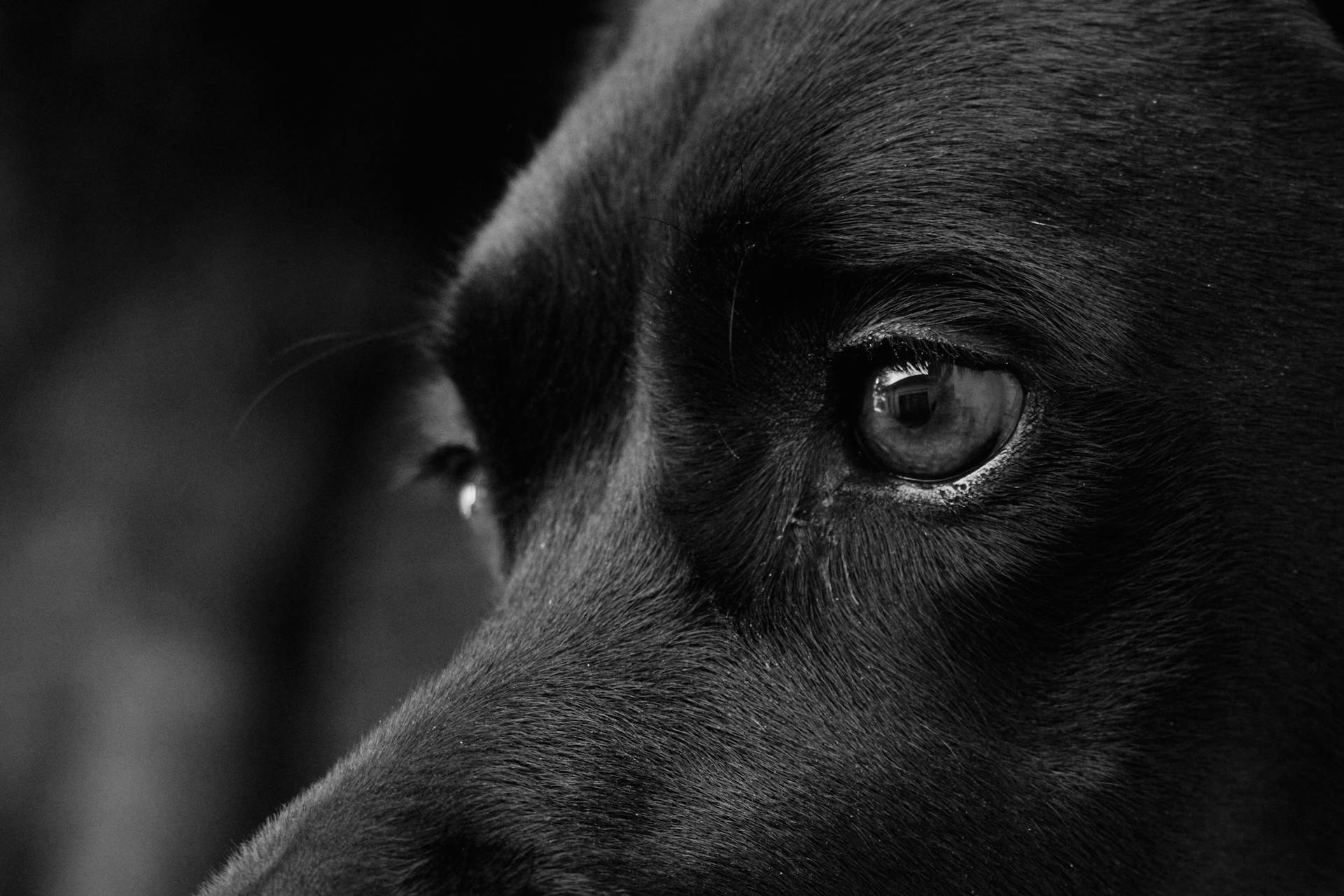
Dogs can get different types of eye infections, some of which are more common than others. Conjunctivitis is a type of eye infection that affects the outer layer of the eye and inner eyelid.
Redness, discharge, and squinting are common symptoms of conjunctivitis. It's usually caused by a bacterial or viral infection.
Blepharitis is another type of eye infection that affects the eyelids. It can cause redness, swelling, and crusting on the eyelids.
In some cases, blepharitis can lead to conjunctivitis. Regular grooming and cleaning of the eyes can help prevent both conditions.
Discover more: What Type of Dog Is Marmaduke?
Causes and Symptoms
Dog eye infections can be caused by a variety of factors, including corneal abrasions, dry eye syndrome, and infection of the eyelids. Corneal abrasions can be caused by trauma, such as rubbing at the eye or a grain of sand entering the eye, while dry eye syndrome is a condition where the eye doesn't produce enough tears, leading to a buildup of mucus and bacteria.
Some common causes of dog eye infections include viral and bacterial infections, allergies, and trauma to the eye. Infections can also be caused by foreign objects in the eye, such as dust, sand, or foxtails. Dry eye syndrome, also known as keratoconjunctivitis sicca, can cause a buildup of mucus and bacteria in the eye, leading to infection.
Here are some common symptoms of dog eye infections:
- Redness and discharge from the eye
- Pawing at the eye or keeping the eye closed
- Excessive winking or blinking
- Yellow-green discharge from the eye
- Prolapse of the third eyelid
- Swollen eyelids and light sensitivity
Understanding the Causes
Corneal abrasions are a common cause of eye infections in dogs, often resulting from trauma, such as a dog rubbing its eye or a grain of sand entering the eye.
Trauma can also occur when a dog rushes through bushes and gets poked by a thorn or stick, which is a particular risk for hunting dogs.
Dr. Pinard advises prompt veterinary care for corneal abrasions.
Dry eye syndrome, also known as keratoconjunctivitis sicca, is another common cause of eye infections in dogs, characterized by a lack of tears and the accumulation of mucus.
Curious to learn more? Check out: Yeast Infections

This condition can be caused by a reaction to medication or if the dog was not properly treated at the beginning of clinical signs.
The signs of dry eye syndrome include a lack of tears, mucus accumulation, and an overwhelming number of bacteria that were not flushed due to a lack of tears.
Infection of the eyelids can also lead to eye infections in dogs, often presenting with swollen, red eyelids and lumps or bumps that rupture into skin ulcers.
These cases should be seen by a veterinarian within a week of presenting symptoms.
Conjunctivitis is a common cause of eye infections in dogs, with specific causes including viral infections, bacterial infections, immune-mediated disorders, tumors, and breed-associated conditions.
Some of the most common causes of conjunctivitis include viral infections such as canine distemper virus or canine herpesvirus, bacterial infections such as Staphylococci, and immune-mediated disorders such as allergic conjunctivitis.
Tear film deficiency, such as keratoconjunctivitis sicca, can also cause conjunctivitis.
Obstructed tear ducts can cause inflammation of the tissues surrounding the globe of the eye, leading to conjunctivitis.
Expand your knowledge: Types of Dog Ear Infections

Trauma to the eye or irritation from foreign bodies, smoke, or environmental pollutants can also cause conjunctivitis.
Here are some common causes of conjunctivitis in dogs:
- Viral infections (e.g. canine distemper virus, canine herpesvirus)
- Bacterial infections (e.g. Staphylococci)
- Immune-mediated disorders (e.g. allergic conjunctivitis)
- Tear film deficiency (e.g. keratoconjunctivitis sicca)
- Obstructed tear ducts
- Trauma to the eye or irritation from foreign bodies, smoke, or environmental pollutants
Allergies, irritants, infection, trauma, and dry eye are common causes of red eyes in dogs.
Allergens, such as tree, grass, flower, and other pollens, can cause itchiness, redness, and discharge in dog eyes.
Objects like dust, sand, foxtails, and other foreign materials can irritate and cause inflammation and redness of the tissues around the eye.
Infection can cause red eyes in dogs, with a host of different bacteria, viruses, fungus, and other microorganisms potentially causing the problem.
Trauma to the head or face can result in a red eye, such as from rough play with another dog or a scratch to the eye from a cat's claw.
Related reading: Red Eyes in German Shepherds

Dry eye can cause red eyes in dogs, with some dogs developing a decreased ability to produce their natural tear film.
Cherry eye, a condition where the gland within the "third eyelid" becomes inflamed and sticks out onto the surface of the eye, can also cause red eyes in dogs.
Here are some common causes of red eyes in dogs:
- Allergies
- Irritants (e.g. dust, sand, foxtails)
- Infection
- Trauma
- Dry eye
- Cherry eye
Signs of Infection
Redness is a common sign of dog eye infection, making the eyes appear pinker or redder than normal.
Discharge is another key indicator, which can be clear, white, yellow, or yellow-green in color. If the discharge is thicker than normal or colored, it's a sign to have your dog evaluated by a veterinarian.
Eye infections can be itchy or painful, causing your dog to paw at their eyes or drag their face across surfaces, potentially causing further damage.
Swelling of the eyelid can occur, resulting in a swollen or droopy looking eyelid.

Squinting or increased blinking can be a sign of irritation or pain in the infected eye.
Here are some common signs of dog eye infection:
- Redness
- Discharge (clear, white, yellow, or yellow-green)
- Pawing at the eyes
- Swelling of the eyelid
- Squinting or increased blinking
These signs can vary depending on the cause and duration of the infection, and may worsen or improve over time.
Diagnosis and Treatment
A veterinarian-prescribed tear stimulant is really needed to promote natural tearing in dogs with dry eye symptoms.
Your veterinarian will take a history of symptoms and conduct a comprehensive eye exam for diagnosis and prescription of appropriate treatment.
A detailed ophthalmic examination must be performed by your veterinarian, often using an ophthalmoscope, to differentiate between primary and secondary conjunctivitis.
Your veterinarian may measure tear production, intraocular pressure, and perform other tests such as nasolacrimal duct flushing, bacterial culture and sensitivity tests, conjunctival cytology or biopsy, and allergy testing.
Treatment is directed at the specific cause and may include both topical and oral medications, such as topical antibiotics, anti-inflammatory agents, and oral antibiotics and anti-inflammatory drugs.
Most cases of conjunctivitis have a very good prognosis, but severe, chronic, or recurrent conjunctivitis may have a guarded prognosis depending on the diagnosis.
Here are some common tests and procedures that may be performed during diagnosis:
- Measuring tear production (Schirmer tear test)
- Measuring intraocular pressure to rule out glaucoma or uveitis
- Staining the cornea with fluorescein dye to look for underlying corneal injuries or ulcers
- Nasolacrimal duct flushing, bacterial culture and sensitivity tests, conjunctival cytology or biopsy, and allergy testing
Consult with your vet before using any leftover doggy eye drops you have on hand from previous infections because not all eye infections are treated with the same medication.
Worth a look: Ear Infections
How Is Conjunctivitis Diagnosed?
To diagnose conjunctivitis, your veterinarian will perform a thorough ophthalmic examination using an ophthalmoscope to examine the eye and surrounding structures.
The goal of diagnosis is to determine if the conjunctivitis is a primary or secondary problem, meaning there's no underlying eye or eyelid disease.
Your veterinarian may use a Schirmer tear test to measure tear production, which can help identify issues with tear ducts or tear quality.
Intraocular pressure may also be measured to rule out glaucoma or uveitis. This is a crucial step in diagnosing conjunctivitis.
A fluorescein dye test may be performed to look for underlying corneal injuries or ulcers. This involves staining the cornea with a special dye.
Additional tests may include nasolacrimal duct flushing, bacterial culture and sensitivity tests, conjunctival cytology or biopsy, and allergy testing. These tests can help identify the underlying cause of the conjunctivitis.
Here's a list of some of the specific tests that may be performed:
- Schirmer tear test: measures tear production
- Intraocular pressure test: measures pressure inside the eye
- Fluorescein dye test: looks for corneal injuries or ulcers
- Nasolacrimal duct flushing: clears blockages in the tear ducts
- Bacterial culture and sensitivity tests: identifies bacteria causing the infection
- Conjunctival cytology or biopsy: examines cells in the conjunctiva
- Allergy testing: identifies potential allergens causing the conjunctivitis
Treatment
Treatment is key when it comes to helping your dog recover from an eye infection. Topical antibiotics are often prescribed for corneal ulceration, and the choice of antibiotic will depend on the severity.
You should never attempt to treat your dog's eye infection with human medications or leftover dog eye drops from previous infections. This can make the condition worse and even lead to complications.
Your veterinarian will typically prescribe medicated eye drops or ointment to treat the eye condition. Some cases may warrant oral medications as well.
Discover more: Buy Tacrolimus Eye Drops

If your dog is showing signs of eye issues or the discharge returns soon after cleaning it, it's time to check in with your vet and formulate a second course of action. This can help prevent complications and ensure your dog receives the best treatment possible.
Your veterinarian may refer you to a veterinary ophthalmologist if they suspect a severe eye condition. This can provide your dog with specialized care and a better chance of recovery.
In some cases, artificial tears may be prescribed to help with dry eye symptoms. However, a veterinarian-prescribed tear stimulant is often needed to promote natural tearing.
Appropriate treatment gives your dog the best chance to recover with minimal complications. This includes following your veterinarian's instructions for administering medication and preventing your dog from rubbing at their eyes.
Frequently Asked Questions
What can I put on my dog's eye infection?
For a dog's eye infection, use a saline solution, either store-bought or homemade with salt water, to gently clean and soothe the affected area. This simple solution can help reduce discharge and promote healing.
What is the most common eye disease in dogs?
The most common eye disease in dogs is corneal ulcers, which can cause painful and potentially sight-threatening injuries to the cornea. Learn more about the causes, symptoms, and treatment options for this common canine eye condition.
How do you tell if your dog has an eye infection or allergies?
Check for clear discharge and redness, but also consider allergies as a possible cause, especially if symptoms are seasonal or triggered by environmental factors
How did my dog get a bacterial eye infection?
Bacterial eye infections in dogs can be caused by various bacterial diseases, including canine brucellosis, leptospirosis, canine ehrlichiosis, and Lyme disease
Sources
- https://www.akc.org/expert-advice/health/dog-eye-infections/
- https://vcahospitals.com/know-your-pet/conjunctivitis-in-dogs
- https://www.reedanimalhospital.com/blog/five-types-of-dog-eye-discharge-meaning/
- https://www.zoetispetcare.com/blog/article/treat-eye-infections-dogs
- https://www.dailypaws.com/dogs-puppies/health-care/dog-conditions/dog-eye-discharge
Featured Images: pexels.com


